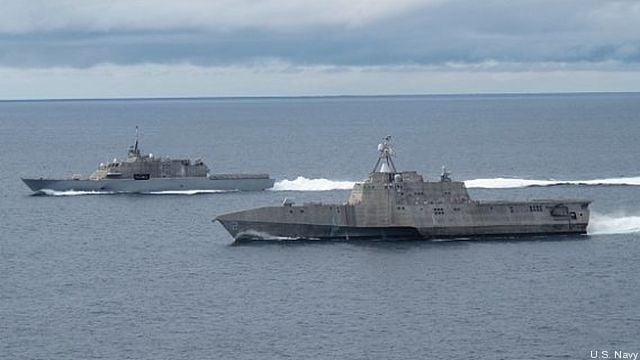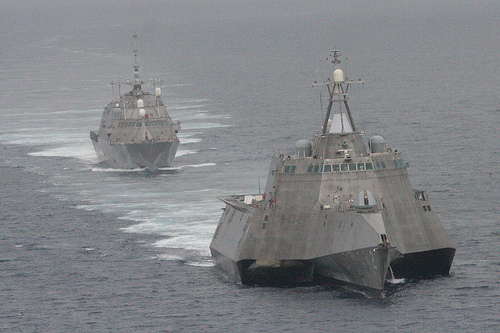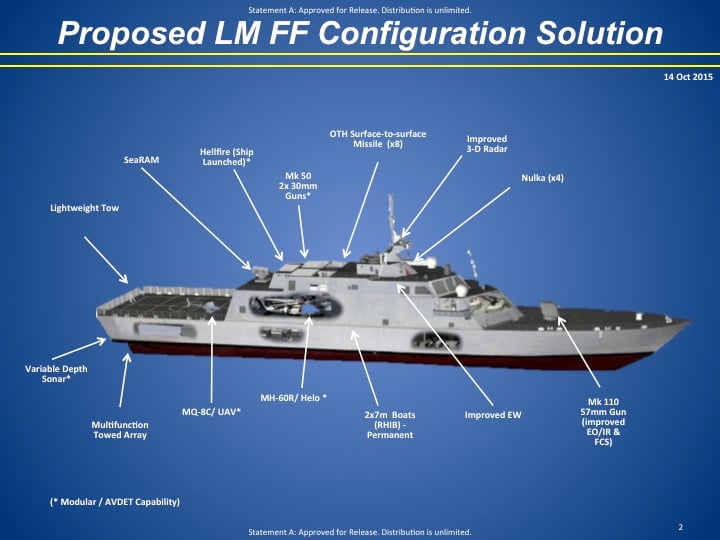LCS Troubles May Stem From Double Engine
Posted on

The two variants of the Littoral Combat Ship — LCS-1 Freedom and LCS-2 Independence
After two years of embarrassing breakdowns in both variants of the embattled Navy Littoral Combat Ship, there are worrying signs that a reliability problem is built into the design. At issue: the unhappy combination of an unusually small crew struggling with a uniquely complex propulsion system, one that yokes gas turbines and diesel engines together.

Vice Adm. Tom Rowden
That implies Vice Adm. Thomas Rowden’s current stand-down to retrain LCS engineers — and it’s unprecedented to stand down an entire warship class — will only solve part of the problem. A complete cure could require redesigning the engines. That’s the kind of fundamental fix that would have to wait for the upgraded “frigate” model of the LCS and which couldn’t be retrofitted to existing ships.
“The Navy may want to…in the frigate design, for example…come up with ways to simplify the propulsion architecture,” said Bryan Clark of the Center for Strategic & Budgetary Assessments, a former top aide to the Chief of Naval Operations.
“It’s not really fundamentally flawed so much as the architecture is hard to support,” Clark said, which is particularly problematic for LCS’s chronically overworked crew. Using a smaller gas turbine would reduce the ships’ top speed, he said, but it would also make maintaining and operating it easier.

LCS-2, USS Independence, followed by LCS-1, USS Freedom, showing the two different designs.
God-Danged CODAG
This diagnosis is only informed speculation on my part, drawing on discussions with experts like Clark and on my own decade-plus of covering LCS. But it’s based on some undisputed facts.
Both LCS variants have an unusually small crew for their size, even after the Navy increased the number of “core” sailors from 40 to 50. An Arleigh Burke destroyer, for instance, is nearly three times as large but has nearly seven times as many crew. It’s been widely reported that LCS’s smaller crew is overburdened by the demands of maintaining and operating a high-tech warship, even with extra contractor support ashore. But what’s not widely appreciated is that this smaller crew has to manage one of the most complex power plants outside the nuclear Navy.
Both LCS variants have a propulsion system not shared by any other major warship: a Combined Diesel And Gas (CODAG) powerplant that connects to both a diesel for fuel efficient, low-speed cruising and a gas turbine for high-speed but gas-guzzling sprints. Every other non-nuclear Navy warship uses either only diesels — as on smaller, slower amphibious ships (LSDs and LPDs) — or only turbines — as on larger amphibs (LHAs and LHDs), cruisers, destroyers, and even the small Perry-class frigates that LCS is meant to replace.
Two breakdowns on the Freedom-class LCS ships occurred in the “combining gear” that links the diesels and turbines together. The Independence LCS doesn’t have a combining gear as such, but Navy Times described that variant’s breakdown as occurring in “the part of the engine where power from its four engines are combined and transmitted to the propulsion system.”
The unique arrangement on LCS was driven by the Navy’s desire for an extraordinarily fast ship: Both variants can sprint at 40 to 45 knots, compared to 30-35 for a destroyer. But as we first reported back in a 2012 interview with then-Rear Adm. Rowden, the Navy never really figured out what to do with all that extra speed.
High speed began as an inspirational aspiration in the proto-LCS concept known as Streetfighter, sometimes envisioned as a 50-knot ship. It became an official requirement during an accelerated development process that shortcut the usual laborious analysis in the name of “transformation” and “acquisition reform.”
“The CNO at the time, (Chief of Naval Operations Adm.) Vernon Clark, wanted a fast ship,” naval historian Norman Polmar told me. “So far as I know there was no analysis done to determine if 45 knots was better than 35 or 50 knots.”
The original crew size of 40 was chosen the same way, compounding the problem, added one Hill staffer: “The lack of a traditional AoA (Analysis Of Alternatives) or certainly the lack of deep analysis led to the small crew requirement as well, one that I personally have been skeptical about from the very beginning. Then, possibly, the small crew and power plant complexity create a self-licking ice cream cone of engineering problems.”
“It’s probably better to have a more deliberate process to come up with a new platform like that that you’re going to keep around for 20 years,” said Bryan Clark (no relation to the CNO). “People complain about that, but in reality for that kind of investment, maybe you want to spend the extra time.”

Lockheed Martin frigate variant
What Need For Speed?
The original concept was that the LCS would engage turbines both to outrun Iranian-style fast attack craft — basically armed speedboats — and to sprint back to port to pick up new mission-specific equipment. The LCS hull can accommodate different “mission modules,” and the original idea was to switch them out rapidly and frequently during operations. But the switch-out proved more complex than expected, and the Navy now plans for each LCS to keep a specific mission module for years on end. So there’s no rush to replace modules anymore.
What’s more, of the three missions finally settled on, high speed is counterproductive for anti-submarine warfare — the noise interferes with sonar — and positively suicidal for minesweeping. That leaves fighting fast attack craft as the only mission requiring speed, but that aspect of LCS’s mission has become less critical as the threat from Chinese and Russian conventional warships has overshadowed Iranian speedboats with RPGs.
Yet as missions shift, LCS remains saddled with a high-speed design. In fact, the whole hull of both variants is optimized for 40-plus knots: the Lockheed Martin-built Freedom class is based on an Italian racing yacht, the Austal Independence on a triple-hulled trimaran ferry. “That’s not the best hull design for driving around at 15 knots, (but) they’re not going to be able to change that,” Clark said: If you redesign the hull, you have to redesign everything.
Fortunately, the hull isn’t breaking down — at least not any more. The original Freedom had a problem with hull cracking from high-speed runs, which Lockheed says it’s fixed, while the lightweight aluminum hull of the Independence had corrosion issues. But the problems of the last two years have been mostly, if not exclusively, related to the engines.
“It’s primarily the power plant,” said Polmar. “There may have been some other minor problems, but the significant ones have been propulsion. And when you have a ship and it’s at sea and suddenly the propulsion plant stops, you have a problem. It’s not as bad as with an airplane, but it’s a problem.”
The current retraining effort makes sense, said Polmar. “It’s a two-fold problem: the machinery itself and the training of the people”, he told me. “If your car keeps breaking down after you take it to the shop, is it because the engine has problems… or the mechanic who was working on it was poorly trained? I don’t think we know completely with respect to the LCS.”
If new training and procedures can fix the Littoral Combat Ships’ reliability issues, that’s great. But the more the problem turns out to be built into the engine, the more intractable and expensive it will be.
Subscribe to our newsletter
Promotions, new products and sales. Directly to your inbox.
